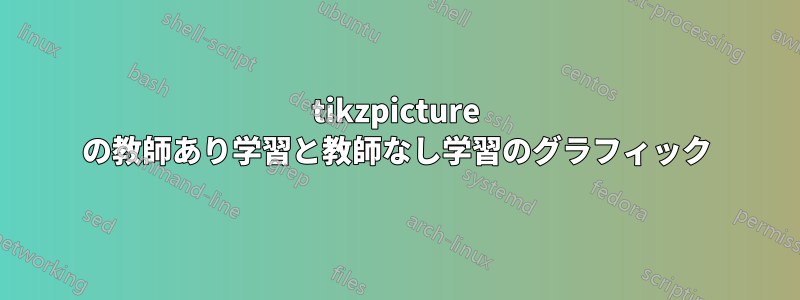
これら 2 つのプロットを を使用して表したいと思いますtikzpicture。以下のように結合する必要はありませんが、似たようなものを作成したいと思います。
以下のように散布図を生成できます。
2 つのユニークで異なるクラスターがあります。教師あり学習の例のように線形に分離可能な線を描画し、教師なし学習の例のクラスターも描画したいと思います。
さらに、色やポイントが大きいとさらに良いでしょう。
コード:
\documentclass{article}
\usepackage{pgfplots}
\begin{document}
\begin{tikzpicture}
\begin{axis}[%
axis lines = left,
xlabel = x,
ylabel = y,
]
\addplot[only marks] table [%
x = x,
y = y,
col sep = comma]{
x, y
%cluster 1
2, 3
3, 5
4, 5
3, 8
5, 9
3, 2
5, 6
6, 6
7, 9
10, 4
11, 5
9, 4
%cluser 2
20, 10
21, 12
24, 12
25, 13
27, 14
22, 13
23, 15
25, 10
15, 14
};
\end{axis}
\end{tikzpicture}
\end{document}
答え1
scatter/classesを使用して 2 つのクラスターのポイントを別々にフォーマットすることもできますが、 を 2 つに分割する方が簡単です\addplot。フォーマットを設定するには、たとえば を使用します\addplot [blue, only marks, mark=*, mark size=5] ...。これは、ほとんど説明不要だと思います。
線と円については、通常の TikZ コマンドを使用するのとほぼ同じです。ただし、デフォルトでは、環境\draw (x,y) ..内でを実行するとaxis、の座標系には含まれないことに注意してください。xyaxisない限りa) を使用するか(axis cs:x,y)、b) \pgfplotsset{compat=1.11}(またはより高いバージョン番号)を追加します。後者の場合はaxis csがデフォルトになります。
さらに、 のcircle[radius=2]内側に がaxis必要ですcompat=1.11(と思う) が、半径は軸座標にあるため、この場合は楕円になります。代わりに、 の内側に座標を定義しaxis、その外側に円を描くこともできます。どちらも以下のコードで示されています。
\documentclass{article}
\usepackage{pgfplots}
\pgfplotsset{compat=1.11} % <-- added
\begin{document}
\begin{tikzpicture}
\begin{axis}[%
axis lines = left,
xlabel = $x$,
ylabel = $y$,
clip mode=individual % so things drawn by \draw and similar are not cut off
]
\addplot [blue, only marks, mark=*, mark size=5] table [%
x = x,
y = y,
col sep = comma]{
x, y
%cluster 1
2, 3
3, 5
4, 5
3, 8
5, 9
3, 2
5, 6
6, 6
7, 9
10, 4
11, 5
9, 4
};
\addplot+[red, only marks, mark=*, mark size=5] table [%
x = x,
y = y,
col sep = comma]{
x, y
20, 10
21, 12
24, 12
25, 13
27, 14
22, 13
23, 15
25, 10
15, 14
};
% to be able to use axis coordinates with \draw directly you need
% \pgfplotsset{compat=1.11} or a higher version
% if that is not present, use (axis cs:4,14) instead of (4,14),
% to specify that the values should be interpreted as axis coordinates
\draw [dashed] (4,14) -- (25,2);
% save a coordinate for use later
\coordinate (c2) at (23,12);
% the blue circle is drawn inside the axis environment, and in axis coordinates
% hence it becomes an ellipse
\draw [blue, dashed] (6,6) circle[radius=5];
\end{axis}
% the red circle is drawn outside the axis, so actually looks like a circle,
% but the radius has no relation to the axis coordinates
\draw [red, dashed] (c2) circle[radius=2cm];
\end{tikzpicture}
\end{document}
2つの軸
2 つのプロットを隣り合わせに表示するには、複数の方法があります。 を 2 つtikzpicture続けて追加するか、axis同じ に 2 つの環境を用意してtikzpicture、2 つ目の環境を を使用して配置することができます。個人的には、軸のグリッドを作成するためのライブラリの環境\begin{axis}[at={(x,y)},...が気に入っています。groupplotgroupplots
\documentclass{article}
\usepackage{pgfplots}
\usepgfplotslibrary{groupplots}
\pgfplotsset{compat=1.11}
\begin{document}
\begin{tikzpicture}
\begin{groupplot}[
group style={
group size=2 by 1,
horizontal sep=1.5cm
},
axis lines = left,
xlabel = $x$,
ylabel = $y$,
width=5cm, % <-- set size of axes
clip mode=individual, % to avoid \draws being cut off
title style={yshift=1mm, font=\bfseries\sffamily}
]
\nextgroupplot[title=Supervised learning]
\addplot [blue, only marks, mark=*, mark size=3] table [%
x = x,
y = y,
col sep = comma]{
x, y
%cluster 1
2, 3
3, 5
4, 5
3, 8
5, 9
3, 2
5, 6
6, 6
7, 9
10, 4
11, 5
9, 4
};
\addplot+[red, only marks, mark=*, mark size=3] table [%
x = x,
y = y,
col sep = comma]{
x, y
20, 10
21, 12
24, 12
25, 13
27, 14
22, 13
23, 15
25, 10
15, 14
};
% to be able to use axis coordinates with \draw directly you need
% \pgfplotsset{compat=1.11} or a higher version
% if that is not present, use (axis cs:4,14) instead of (4,14),
% to specify that the values should be interpreted as axis coordinates
\draw [dashed] (4,14) -- (25,2);
\nextgroupplot[title=Unsupervised learning]
\addplot [blue, only marks, mark=*, mark size=3] table [%
x = x,
y = y,
col sep = comma]{
x, y
%cluster 1
2, 3
3, 5
4, 5
3, 8
5, 9
3, 2
5, 6
6, 6
7, 9
10, 4
11, 5
9, 4
};
\addplot+[red, only marks, mark=*, mark size=3] table [%
x = x,
y = y,
col sep = comma]{
x, y
20, 10
21, 12
24, 12
25, 13
27, 14
22, 13
23, 15
25, 10
15, 14
};
% save a coordinate for use later
\coordinate (c2) at (23,12);
% the blue circle is drawn inside the axis environment, and in axis coordinates
% hence it becomes an ellipse
\draw [blue, dashed] (6,6) circle[radius=5];
\end{groupplot}
% the red circle is drawn outside the axis, so actually looks like a circle,
% but the radius has no relation to the axis coordinates
\draw [red, dashed] (c2) circle[radius=1cm];
\end{tikzpicture}
\end{document}






